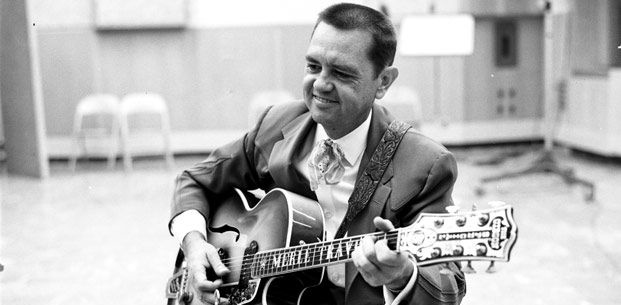Travis picking: how to fingerpick like Merle Travis
Learn to alternate notes with your thumb and you'll expand your fingerstyle abilities no end

Named after legendary country guitar virtuoso Merle Travis, Travis picking is the most popular and commonly used fingerpicking technique.
The technique essentially involves alternating between different thumb-picked bass notes on the lower strings while the fingers pick out melody notes based on chord shapes on the higher strings.
Generally, the thumb palm mutes the bottom three strings and “bounces” back and forth between two bass notes in a steady eighth-note rhythm while melody notes are plucked on the higher strings, either on those same eighth notes or in the 16th-note rhythms that fall between the bass notes, creating a lively syncopation.
In this lesson, I’d like to offer a primer on this very useful and fun playing technique.
FIGURE 1 illustrates the typical bass movement, as a pair of E notes, one octave apart, are alternately picked in steady eighth notes with the thumb, as the fret hand forms open E chord shape.
In FIGURE 2, I add melody notes on the higher strings, beginning in bar 2. On beat two, the thumb picks the open low E string, followed immediately by a middle-finger pluck of the open B string. The thumb and index finger then simultaneously pick the fourth and third strings, immediately followed by a hammer-on from the open G note to G# at the first fret, creating a bluesy sound. I begin bar 3 by simultaneously picking the outer strings with the thumb and middle finger, then pull off from the high G note on the first string’s third fret to the open note.
This is followed by the “middle” E note on the fourth string’s second fret, picked with the thumb, after which I pick the open B string and hammer-on to the third-fret D note while thumb-picking the middle E note on the fourth string again, momentarily breaking the alternating octaves bass pattern. The phrase ends with the open high E note followed by a low G note on the sixth string, to which I apply a slight, quarter-step bend for a “swampy” effect.
All the latest guitar news, interviews, lessons, reviews, deals and more, direct to your inbox!
A useful practice technique is to take a one-bar pattern and loop it, as shown in FIGURE 3. Repeat this pattern until it feels comfortable and coordinated under your fingers, then tackle FIGURE 4, which is a two-bar phrase that includes the pattern introduced in bar 3 of FIGURE 2.
A great way to use Travis picking is to apply it to a 12-bar blues progression. In the key of E, the three chords used in a basic 12-bar blues are E7, A7 and B7, which are the one, four and five chords, respectively. We’ll use the patterns I’ve already shown you for the one chord, E7. FIGURE 5 illustrates the two-bar pattern we’ll use for A7. Here, the thumb alternates between the fifth and fourth strings while the fingers pick out notes on the top three strings, based around an open A7 chord shape. Notice that bar 2 includes both a hammer-on and a pull-off on the B string.
FIGURE 6 shows the one-bar pattern we’ll use for the five chord, B7, and FIGURE 7 provides the one-bar version of A7 that falls in bar 10 of the progression. FIGURE 8 is a Jerry Reed–style single-note phrase, played across bars 11 and 12. I begin by picking the sixth and third strings together then hammering on from D# to E on the third string, followed by a cascade of ringing notes played across the top four strings. Notice how the open B and high E strings at the end of bar 1 conveniently facilitate a shift back down to first position.
Finally, FIGURE 9 puts everything together into a Travis-picked 12-bar blues, with a three-note pickup leading into bar 1 of the progression. The nice thing about this type of arrangement is that it provides both melody and accompaniment.

